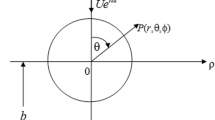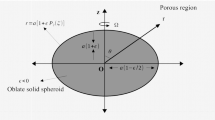Summary
The effect of boundary proximity on the drag experienced by a particle of arbitrary shape translating parallel to a principal axis of translational resistance is theoretically calculated, at small Reynolds numbers, for the case in which it falls along the axis of a circular cylinder filled to a finite depth with viscous liquid. The body may occupy any position along the cylinder axis. Owing to the presence of the cylinder walls, the cylinder bottom and the free surface, the translational resistance encountered by the body is greater than would obtain in an unbounded fluid medium. Results are expressed in terms of the ratio of drag forces experienced by the body in the bounded and unbounded fluids, respectively, when moving with the same speed and orientation in the same fluid. Numerical values are provided which enable this ratio to be computed from the fundamental geometrical parameters of the system. The computation furnishes the wall correction correctly to the first-order in the ratio of characteristic particle dimension to characteristic distance of the particle from the nearest boundary.
The results find application to the settling of particles in the Stokes regime, as well as in the general theory of the falling-ball viscometer.
Similar content being viewed by others
Abbreviations
- a :
-
characteristic particle dimension
- A :
-
integration constant
- A n :
-
integration constant (n=1, 2, 3, 4)
- b :
-
distance from center of particle to free surface of liquid
- B :
-
integration constant
- B n :
-
integration constant (n=1, 2, 3, 4)
- c :
-
distance from center of particle to rigid bottom of container
- C :
-
integration constant
- D :
-
integration constant
- E2 :
-
Stokes operator defined in equation (2.15)
- f(z):
-
arbitrary scalar function of z
- f 1(b/R 0):
-
function of argument b/R 0 defined in equations (8.9)–(8.10)
- \(\bar f\)(m):
-
finite Fourier sine transform defined in (10.5c)
- \(\bar f\)(x):
-
transformed variable defined in (9.36b)
- \(\bar f\)(α):
-
Fourier sine transform defined in (9.28)
- F=i z F :
-
hydrodynamic force experienced by translating particle in the bounded fluid
- F ∞ =i z F ∞ :
-
hydrodynamic force experienced by translating particle in an unbounded fluid
- \(\bar F\)(m):
-
transformed variable defined in (10.9b)
- \(\bar F\)(x):
-
transformed variable defined in (9.36b)
- g(R):
-
arbitrary scalar function of R
- \(\bar g\)(n):
-
finite Hankel transform defined in (9.20)
- \(\bar G\)(n):
-
finite Hankel transform defined in (9.36a)
- H 1(b/l):
-
function of b/l defined in (6.3)
- i :
-
√ − 1 = imaginary number
- i R :
-
unit vector in R-direction
- i z :
-
unit vector in z-direction
- I n :
-
modified Bessel function of the first kind of order n
- J n :
-
Bessel function of the first kind of order n
- K n :
-
modified Bessel function of the second kind of order n
- l :
-
distance between free plane surface and rigid plane surface
- L :
-
characteristic distance from center of particle to boundary
- \(\bar L\)(n):
-
transformed variable defined in (9.55) or (10.15)
- m :
-
an integer or summation index
- n :
-
an integer or summation index
- N n :
-
real part of β n (see § 7)
- p :
-
dynamic fluid pressure corresponding to v
- p*:
-
dynamic fluid pressure
- p (1) :
-
dynamic fluid pressure corresponding to v (1)
- p (2) :
-
dynamic fluid pressure corresponding to v (2)
- P n :
-
imaginary part of β n (see § 7)
- Q n :
-
functions defined in the Appendix (n=1, 2)
- r :
-
an integer or summation index
- r :
-
position vector of an arbitrary point in the fluid
- r′ :
-
position of the singular point in the fluid
- R :
-
radial distance in cylindrical coordinates
- R 0 :
-
radius of circular cylinder
- S n :
-
real part of J 0(β n ) (see § 7)
- t :
-
time
- T n :
-
imaginary part of J 0(β n ) (see § 7)
- u(z):
-
arbitrary scalar function of z
- U :
-
translational velocity of the particle, −i z U
- υ :
-
fluid motion arising from action of point force in the bounded fluid, i z υ z +i R υ R
- υ*:
-
local fluid velocity
- υ (1) :
-
fluid motion arising from action of point force in the unbounded fluid
- υ (2) :
-
reflected velocity field defined by υ − υ (1)
- υ (2)0 = i z · υ (2)0 :
-
where v (2)0 is the numerical value of v (2) at the singularity (R=0, z=z′)
- W :
-
wall effect coefficient defined in (2.9)
- W 1(b/l):
-
wall effect coefficient, function of b/l, defined in (6.5a)
- W 2(b/l):
-
wall effect coefficient, function of b/l, defined in (6.5b)
- W 3(b/R 0):
-
wall effect coefficient, function of b/R 0, defined in § 8
- W 4(b/R 0):
-
wall effect coefficient, function of b/R 0, defined in § 8
- W 5(c/R 0):
-
wall effect coefficient, function of c/R 0, defined in (9.54)
- W 6(c/R 0):
-
wall effect coefficient, function of c/R 0, defined in (9.57)
- W 7(l/R 0, c/l):
-
wall effect coefficient, function of l/R 0 and c/l, defined in (10.12)–(10.13)
- W 8(l/R 0, c/l)=(l/R 0) W 7 :
-
wall effect coefficient, function of l/R 0 and c/l
- x :
-
a variable or integration parameter
- y :
-
integration variable
- Y n :
-
Bessel function of the second kind of order n
- z :
-
coordinate measured parallel to cylinder axis
- z′ :
-
z-coordinate of the singular point in the fluid
- α :
-
a variable or integration parameter
- β :
-
a variable
- β n :
-
n'th root of the transcendental equation (7.7)
- δ(r−r′):
-
Dirac delta function see (2.16)
- θ :
-
variable defined by (3.16)
- \(\bar \theta\)(α, z):
-
transformed variable defined by (3.17)
- \(\bar \theta\)(n, z):
-
transformed variable defined by (9.8)
- \(\bar \theta\)(α, n):
-
transformed variable defined by (9.23)
- κ :
-
a positive dimensionless constant defined in (2.3)
- λ :
-
a variable
- λ n :
-
n'th root of the transcendental equation (9.9)
- μ :
-
fluid viscosity
- φ :
-
angle in cylindrical coordinates or variable defined in (3.2)
- \(\bar \phi\)(R, α):
-
transformed variable defined by (3.1) or (9.27)
- ψ :
-
Stokes stream function defined in (2.11) corresponding to v
- ψ 1 :
-
Stokes stream function corresponding to v (1)
- ψ 2 :
-
Stokes stream function corresponding to v (2)
- ψ′ :
-
auxiliary stream function, defined in (9.4) or (10.2)
- ψ″ :
-
auxiliary stream function, defined in (9.5) or (10.3)
- ψ‴ :
-
auxiliary stream function, defined in (9.6) or (10.4)
- ψ (iV) :
-
auxiliary stream function, defined in (9.43) or in § 10
- \(\bar \psi\) abovbar}(R, α):
-
transformed stream function defined by (3.7) or (8.1)
- \(\bar \psi\) abovbar}(R, m):
-
transformed stream function defined by (10.5)
- Ω :
-
variable defined in (3.12)
- \(\bar \Omega\)(α, z):
-
transformed variable defined in (3.11)
- \(\bar \Omega\)(n, z):
-
transformed variable defined in (9.19)
- ▽ :
-
(∂/∂ r), a vector operator
- f:
-
final value
- i:
-
initial value
- R :
-
component in R-direction
- z :
-
component in z-direction
- ∞:
-
infinite medium
References
Happel, J. and H. Brenner, Low Reynolds Number Hydrodynamics. Prentice-Hall, Englewood Cliffs, New Jersey, 1965.
Brenner, H., Chem. Eng. Sci. 16 (1961) 242.
Tanner, R. I., J. Fluid Mech. 17 (1963) 161.
Brenner, H., Chem. Eng. Sci. 18 (1963) 1.
Brenner, H., Chem. Eng. Sci. 19 (1964) 599.
Brenner, H., Appl. Sci. Res. A 13 (1964) 81.
Oberbeck, H. A., J. reine angew. Math. 81 (1876) 62.
Brenner, H., J. Fluid Mech. 12 (1962) 35.
Brenner, H., J. Fluid Mech. 18 (1964) 144.
Williams, W. E., J. Fluid Mech. 24 (1966) 285.
Friedman, B., Principles and Techniques of Applied Mathematics. John Wiley and Sons, New York, 1956.
Sneddon, I. N., Fourier Transforms pp. 71–91. McGraw-Hill, New York, 1951.
Sonshine, R. M., Ph. D. Thesis, New York University, 1966.
Sonshine, R. M. and H. Brenner, Appl. Sci. Res. A (in the press) 1966.
Tranter, C. J., Integral Transforms in Mathematical Physics (2nd ed.) pp. 1–12. John Wiley and Sons, New York, 1956.
McLachlan, N. W., Bessel Functions for Engineers pp. 190–206. Clarendon Press, Oxford, 1955.
Spiegel, M. R., Applied Differential Equations pp. 168–171. Prentice-Hall, Englewood Cliffs, New Jersey, 1958.
Lamb, H., Hydrodynamics, 6th ed. Cambridge Univ. Press, Cambridge, 1932.
Handbook of Mathematical Functions, Appl. Math. Ser. No. 55 pp. 887, 890, 916, 923. National Bureau of Standards (U.S. Commerce Dept.), Washington, D.C., 1964.
Ladenburg, R., Ann. Phys. 23 (1907) 447.
Oseen, C., Neuere Methoden und Ergebnisse in der Hydrodynamik. Akademische Verlagsgesellschaft, Leipzig, 1927.
Sokolnikoff, I. S. and R. M. Redheffer, Mathematics of Physics and Modern Engineering. McGraw-Hill, New York, 1958.
Haberman, W. L. and R. M. Sayre, David Taylor Model Basin Report No. 1143, Washington, D.C.: U.S. Navy Dept., 1958.
Hildebrand, F. B., Methods of Applied Mathematics pp. 1–4. Prentice-Hall Englewood Cliffs, New Jersey, 1961.
Bohlin, T., Trans. Roy. Inst. Technol. (Stockholm), No. 155 (1960).
Author information
Authors and Affiliations
Additional information
Part II of this paper will appear in the next issue.
Part II of this paper will appear in the next issue.
Rights and permissions
About this article
Cite this article
Sonshine, R.M., Cox, R.G. & Brenner, H. The stokes translation of a particle of arbitrary shape along the axis of a circular cylinder. Appl. Sci. Res. 16, 273–300 (1966). https://doi.org/10.1007/BF00384073
Received:
Issue Date:
DOI: https://doi.org/10.1007/BF00384073




